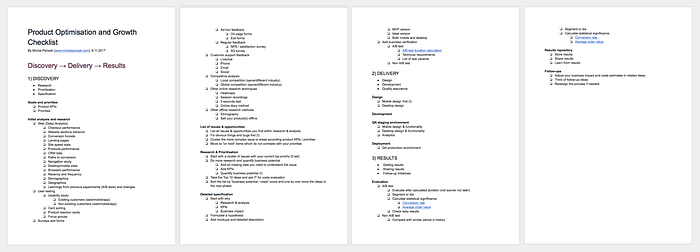Product Optimisation and Growth Checklist
A systematic process for growing online businesses by using CRO techniques
There are many CRO checklists around (by Crazyegg, by MOZ, by Hubspot etc.). But most of them focus on specific tips like Keep your forms linear, Show product close-up videos, Enable out of stock notifications etc.
Those tips are usually solid, and following them might improve your conversion rates. But over the years I’ve been in the industry, one the most important lessons I have learned has been not to blindly trust all those shiny case studies and guaranteed tips and ways how to improve your conversion rate.
Every business is unique and has unique customers. And usually, you need to figure out what are the most important to things to focus on by yourself. By using data, talking to your customers, A/B testing and other research techniques.
The checklist I’ve created focuses on process instead of specific things you should change at your website.
I follow it in my day-to-day work and it helps me not to forget about some important step.
It consists of three major parts:
- Discovery: The first, and most important stage, is mainly about doing a proper research and proper prioritisation.
- Delivery: The 2nd stage focuses on design (preferably mobile first), often underestimated quality assurance and development
- Results: In last part, I list steps you shall follow when you evaluate your A/B tests and the activities which follow it.

Download the Product Optimisation and Growth Checklist (PDF)
In the rest of the blog post, I'd like spend few words about what the checklist consists of, and what made me to create it.
The original purpose was to hand out the checklist to participants of the Marketing Festival 2017 training I had this autumn in Prague. And, since I’ve received good feedback I decided to share it with a broader audience.
Let me describe you the key parts and what I particularly find important.
1. Discovery
Always start with figuring out what you want to achieve. Do you strive for more users, higher conversion rate, more frequent purchases or higher AOV? This decision will narrow your focus to the area you’re interested the most.
Discovery is mainly about research and getting insights. There are dozens of different research techniques. You don’t have to do every single one from the checklist. Pick carefully the ones which make the most sense for your project.
In my eyes, the most versatile and useful research techniques are:

- Analytics, e.g. section analysis for e-commerce projects: It is a very useful analysis for seeing the big picture of your site/app. It helps you figure out where users spend most of their time and where your key (micro)conversions happen. Think about how to boost traffic to low traffic but high-performance sections. And how to further improve the key sections which get the most of traffic (and conversions).
- Usability testing: Observing humans using your products is a priceless and eye-opening technique. I recommend observing both your customers and not (yet) customers. And test both mobile and desktop versions. You can combine it with in-depth interviews to learn more about your customers and prospects.
- Surveys: Listening to the voice of your customers can give your answers to the most painful questions (Why did they not renew their subscription? Why did they abandon the checkout process? What made them not make a second order?). Just be aware of the limitations and pitfalls.
Prioritisation
One of the most critical steps in the Discovery phase is a prioritisation. Invest your time & energy, and for every idea calculate the business potential. You can’t just execute every idea you come up with. You need to filter them and sort them accordingly to how much they contribute to the bottom line.
To do that, you need to understand the issue first. You are unable to make good estimates without the understanding. That means getting as much information as you can (both qualitative and quantitative data). And then calculate the potential. It might look something like that:

2. Delivery
This phase begins as you hand out your specification of the New Killing Feature Which Boosts Conversion By 150 % to the designers and developers.
Make sure your designers are using a mobile first approach which means they start with the mobile design first and doing a desktop design afterward. I love this illustration which explains the point clearly.

Another key step is a thorough Quality Assurance (QA). Look before you leap! Insufficient QA can ruin your perfect idea, cost you tons of money and smash your reputation. Remember, you are the owner of the idea and you’re responsible for the results. So get your hands dirty and do a QA yourself too.
3. Results
Regardless you launch the new feature with A/B testing or not, you should always take these two techniques into consideration:
- Statistical significance calculation: Make sure you verify the change in your KPI from a statistical point of view. I became a fan of Evan Miller’s calculators. He is one the few people who offer a tool for AOV check of statistical significance.
- Segmentation: The gems are usually hidden in more detailed data. Check for what segments the new feature worked and where not. Decide whether to full-scale it to all users or just to a fragment of it. Segmentation also helps you with a better understanding of the results.
The A/B testing is my favourite way how to evaluate a new idea or a feature. If you have enough traffic and conversions (use Sample Size Calculation to find out) to use it, do so. It is important to run your experiment for the calculated length of time. Do not stop it sooner or later (unless you’re losing a lot of money or you find a bug). When evaluating, use segmentation and check the statistics.
If you do not have a lot of knowledge in A/B testing, educate yourself. There are tons of good material online. Like this A/B testing guide by ConversionXL. You might also find useful my piece on the A/B testing pitfalls.
Do not forget to store all your results and share it with the key stakeholders (not just successes, but failures too!).
Use the results to better understand your customers and prospects. Make the results be one of your key Discovery inputs. Learn.
The complete Product Optimisation and Growth Checklist is available to download for free.
Please, let me know your feedback. Regardless it is positive or negative. I’d love to know what you think of it.
If you like the content, please share amongst your peers! And, if you are using a different approach, share it in the comments, please.
Thank you, I hope you’ve enjoyed it.
